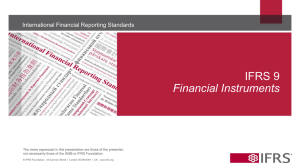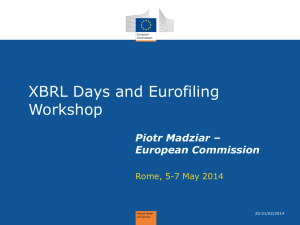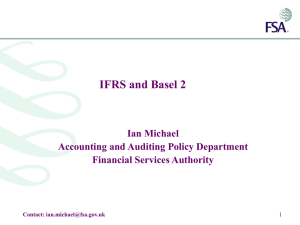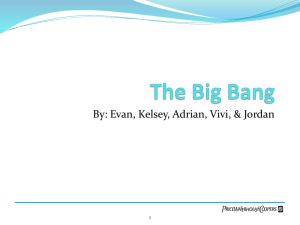An accounting classification based on IFRS practices
advertisement
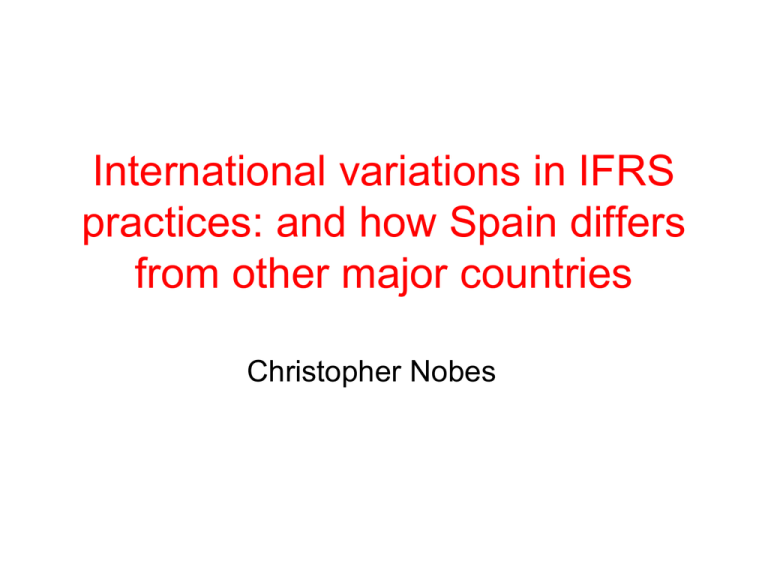
International variations in IFRS practices: and how Spain differs from other major countries Christopher Nobes Presenter: • Dr Christopher Nobes is Professor of Accounting at the University of London and at the University of Sydney. He is Adjunct Professor at the Norwegian Business School. He has taught in Universities in New York and San Diego, and has been a visiting professor in Amsterdam, Barcelona and Venice. • He was a member of the Accounting Standards Committee of the UK and Ireland (1987-90) and of the Board of the International Accounting Standards Committee (1993-2001). • He is the author of 14 books and former co-editor of Accounting and Business Research. He was the 2002 “Outstanding International Accounting Educator” of the American Accounting Association. Tomorrow the world? • The IASC began work in 1973, but the important adoption of IFRS only started in 1994, with a few German companies • “The global rollout of International Financial Reporting Standards is gaining momentum, with more than 100 countries now using IFRS and all of the world’s major countries anticipated to be on board within the next few years” (BDO, 2012) Overview of this presentation • An antidote to these wild claims is needed • Even where IFRS is used, Nobes (2006 in ABR) suggests motivation and scope for different national versions of IFRS practice, including lists of “overt options” • Many researchers have used this as a starting point • This lecture reviews the findings (see Nobes in ABR 2013) Methods of implementing IFRS (consolidated statements of listed companies) Implementing IFRS Adopting the process Standard-by-standard As issued by IASB Israel South Africa Canada Fully converged with IFRS Australia Optional As issued by IASB, but with deletions EU Switzerland Possible Yes Company compliance with IFRS as issued by the IASB Not fully converged China Venezuela Unlikely IFRS implementations for domestic companies, 31 Dec 2012 year ends 1 Jurisdiction 2 3 IASB-IFRS IASB-IFRS required required for all for cons’d regulated reports of reporting listed co.s ? (CSLC)? 4 5 6 7 Version of IFRS Version of Version of (intended to IFRS allowing IFRS allowing ensure compliance compliance compliance with IASB-IFRS with IASB-IFRS with IASB-IFRS) required for required for required for all reporting? CSLC? CSLC? Y (2005) N Y 8 Australia N N Version of IFRS (intended to ensure compliance with IASB-IFRS) required for all reporting? N Version of IFRS (allowing IASBIFRS) required (or allowed=A) for unconsolidated reporting? N (A) Canada N N N N N N N (A) China N N N N N N N France N N N N N Y (2005) N Germany N N N N N Y (2005) N Hong Kong N N N N N N N India N N N N5 N N N Japan N N N N N N N Russia N Y (2012) N Y N Y N South Africa N Y (2005) N Y N Y N (A) South Korea N N N Y (2011) N Y N (A) Spain N N N N N Y (2005) N Switzerland N N N N N N N UK N N N N N Y (2005) N (A) Conclusion so far • Research needs a good institutional setting • But, for example, Francis et al. (2008 in EAR) say that most unlisted companies in most of 56 countries (e.g. Spain) had adopted IFRS in 1999/2000 How IFRS Practices Can Differ Eight opportunities for differences in IFRS practices 1. 2. 3. 4. 5. 6. 7. 8. Different versions of IFRS (see slide 5) Enforcement, compliance (varies nationally) Language Gaps in IFRS Measurement estimations First-time adoption Overt options Covert options 3: Different translations • IAS 7 (para. 7): An investment normally qualifies as a cash equivalent only when it has a short maturity of, say, three months …(Portuguese omits the ‘say’) • IAS 19 (para. 78): discount rate for pension obligations uses interest rate on “commercial bonds” (German says Industrieanleihen) • IAS 41 (para. 34): account for a government grant when receivable (Norwegian, until 2012, said “received”) 4, 5, 6: Gaps, measurement, firsttime adoption • Gaps: e.g. IFRSs 4 and 6; and accounting for artworks (see Dubai law case in 2012: http://www.dfsa.ae/WhatsNew/DispForm.a spx?ID=227) • Measurement estimations: list in Nobes 2006 paper still applies, plus IFRS 7 • First-time adoption: e.g. survival of large initial differences in starting positions on goodwill Eight opportunities for differences in IFRS practices 1. 2. 3. 4. 5. 6. 7. 8. Different versions of IFRS Enforcement, compliance Language Gaps in IFRS Measurement estimations First-time adoption Overt options Covert options 7, 8: Overt and covert options • List of overt options has been used by several researchers Examples of 2005/6 choices (% of companies) Australia UK France Spain Germany 1a) income statement by function 59.3 47.2 54.8 4.0 76.5 1b) by nature 29.6 13.9 45.2 96.0 23.5 1c) neither 11.1 38.9 0.0 0.0 0.0 3a) equity acc profit in operating 63.2 24.5 6.9 0.0 18.8 3b) immediately below 15.8 34.0 3.4 8.3 62.5 3c) below finance 21.1 41.5 89.7 91.7 18.8 14a) FIFO only 27.3 57.1 11.5 5.9 0.0 14b) weighted average only 59.1 30.6 57.7 88.2 71.4 15a) actuarial gains/losses to OCI 72.7 84.4 20.0 12.5 47.6 15b) to income in full 18.2 3.3 5.7 37.5 0.0 15c) corridor 9.1 12.2 74.3 50.0 52.4 7, 8: Overt and covert options • List of overt options has been used by several researchers • A few options have since been removed by IASB (e.g. expensing of interest, treatment of AGL, proportional consolidation) • Covert options include such issues as recognising impairments and capitalising development costs • Paper (ABR, 2013) presents extended lists Why would options/estimations be done differently? • Tax? For example, tax-driven choices flowing through from unconsolidated statements (e.g. AVCO in Germany) • Inertia? • Cost-saving; helping analysts? Empirical Studies First empirical studies • Non-systematic samples of choices: KPMG & von Keitz, 2006; ICAEW, 2007; EC, 2008 • Morais (2008) and Fasshauer et al. (2008) look at actuarial gains/losses in the EU • Kvaal & Nobes (ABR in 2010) study 16 options for 232 companies in 2005/6 ABR, 2010 paper • Five largest IFRS-using stock markets: Australia, France, Germany, Spain, UK • Index companies (e.g. ASX 50, FTSE 100) • 2005/6 statements • 16 policy choices (e.g. FIFO or weighted average; proportional consolidation for JVs) Hypotheses • Null hypothesis of same practice in all countries • 19 alternative hypotheses (assuming continuation of previous policies) • H3: French and Spanish companies are more inclined than others to show equity-accounted profits after finance items • H16: The tendency to use proportional consolidation is found in the following countries in decreasing order: France, Spain, Germany, UK, Australia • 84 tests: 69 reject null hypothesis at 1%; 7 at 5%; 8 not rejected Policy choices (% of companies by country) 1a) income statement by function 1b) by nature 1c) neither 2a) inclusion of a line for EBIT or op profit 3a) equity acc included in operating 3b) immediately below 3c) below finance 4b) showing net assets 5b) liquidity increasing 6b) OCI only 7b) indirect cash flows 8a) dividends received as operating 9a) interest paid as operating 10b) some PPE at fair value 11b) investment property at fair value 12a) some fair value designation 13a) interest capitalization 14a) FIFO only 14b) weighted average only 15a) actuarial gains/losses to OCI 15b) to income in full 15c) corridor 16a) proportional consolidation of JVs Australia 59.3 29.6 11.1 51.9 63.2 15.8 21.1 100.0 0.0 65.9 0.6 87.5 90.9 13.6 42.9 29.6 75.8 27.3 59.1 72.7 18.2 9.1 0.5 UK 47.2 13.9 38.9 97.2 24.5 32.1 43.4 84.7 100.0 83.7 98.0 36.7 68.4 12.2 73.1 12.5 47.5 50.0 29.2 84.4 3.3 12.2 22.4 France 54.8 45.2 0.0 100.0 6.9 3.4 89.7 0.0 100.0 5.7 100.0 92.9 88.6 0.0 0.0 32.3 40.0 11.5 57.7 20.0 5.7 74.3 81.3 Spain 4.0 96.0 0.0 96.0 0.0 8.3 91.7 0.0 96.3 25.0 87.5 50.0 38.7 0.0 0.0 12.0 94.4 5.9 88.2 12.5 37.5 50.0 84.6 Germany 76.5 23.5 0.0 100.0 18.8 62.5 18.8 0.0 85.0 21.7 100.0 66.7 61.9 0.0 0.0 5.9 22.2 0.0 71.4 47.6 0.0 52.4 31.3 Examples of Spanish choices • Why choose the ‘by function’ income statement? • Actuarial items are large, out-of-control and (usually) losses. Why would Spanish companies choose to include them in ‘earnings’? • Why did Spanish companies choose proportional consolidation? It makes sales and cash larger, but….? Do policy choices change over time? • Kvaal & Nobes (EAR, 2012) look at all changes from 2005 to 2008 • H1: more change on transition than from 2005 to 2008 (not for France/Spain) • H2: more continental change than Anglo change (yes) • H3: variance greater for continentals (yes) • No effect of IASB proposed changes Some policy changes from 2005 to 2008 Australia UK France 2005 2008 2005 2008 2005 65.0 67.5 83.5 90.6 2.9 0.0 8.3 Some investment property at fair value 38.5 39.3 72.0 70.8 0.0 Interest capitalization 81.3 84.4 50.0 57.7 AGL to OCI 73.3 86.7 82.9 AGL to corridor 10.0 6.7 Proportionate consolidation 3.8 11.5 OCI presented Indirect cash flows 2008 Spain 2005 2008 Germany 2005 2008 43.5 63.3 50.0 28.6 64.3 100.0 100.0 90.5 100.0 14.3 0.0 13.3 5.9 5.3 46.2 44.4 94.1 100.0 22.2 41.7 86.4 20.6 50.0 14.3 63.2 45.5 63.3 13.4 9.9 76.5 47.1 50.0 10.5 54.5 33.3 20.0 23.3 80.6 75.8 87.0 91.3 31.3 15.8 100.0 100.0 100.0 100.0 Do small companies make different choices? • Nobes & Perramon (AAR, 2013) • Same five countries; 2008/9; compare to small listed companies • Small companies make different choices (and more homogeneous within country) Policy choices (percentages of companies by country) AUS 1 (a) 2 (a) 3 (a) 4 (b) 5 (b) 6 (b) 7 (b) 8 (a) 9(b) 10(b) 11(a) 12(a) 13(b) 14(a) 15(a) Large income statement by function 58.3 line for operating profit 58.3 equity profit in ‘operating’ 64.7 focussing on net assets 100.0 liquidity increasing 0.0 OCI only 70.8 indirect cash flows 8.3 interest paid as ‘operating’ flow 87.5 some PPE at fair value 0.0 investment property at fair value 0.0 some fair value designation 25.0 interest capitalisation 87.0 weighted average only 52.9 actuarial gains/losses to OCI 84.2 proportional consolidation 18.8 Small 35.3 18.9 16.7 97.5 0.0 12.5 0.0 91.2 13.2 100.0 63.0 61.9 30.8 50.0 33.3 UK Dif. -23.0 -39.4 -48.0 -2.5 0.0 -58.3 -8.3 +3.7 +13.2 +100.0 +38.0 -25.1 -22.2 -34.2 +14.6 Large 50.8 98.4 40.8 85.2 100.0 92.1 100.0 65.1 3.2 25.0 11.1 54.3 32.6 88.3 20.9 Small 100.0 100.0 55.6 45.0 100.0 50.0 100.0 68.6 7.5 75.0 12.0 37.5 30.0 92.3 41.7 GER Dif. +49.2 +1.6 +14.7 -40.2 0.0 -42.1 0.0 +3.5 +4.3 +50.0 +0.9 -16.8 -2.6 +4.0 +20.7 Large 82.6 91.3 22.7 0.0 69.6 43.5 100.0 68.2 0.0 0.0 17.4 43.5 75.0 73.9 18.8 Small 36.0 96.0 15.4 0.0 92.0 8.0 100.0 76.0 0.0 0.0 28.6 11.1 68.4 25.0 42.9 FRA Dif. -46.6 +4.7 -7.3 0.0 +22.4 -35.5 0.0 +7.8 0.0 0.0 +11.2 -32.4 -6.6 -48.9 +24.1 Large 60.0 96.7 10.0 0.0 100.0 13.3 100.0 80.0 0.0 0.0 33.3 40.0 50.0 53.3 72.4 Small 20.0 100.0 0.0 0.0 100.0 0.0 100.0 56.0 0.0 25.0 25.0 16.7 44.4 15.0 100.0 SPA Dif. -40.0 +3.3 -10.0 0.0 0.0 -13.3 0.0 -24.0 0.0 +25.0 -8.3 -23.3 -5.6 -38.3 +27.6 Large 4.8 100.0 0.0 0.0 95.2 42.9 100.0 47.6 0.0 0.0 19.0 100.0 88.2 69.2 93.8 Small 4.0 92.0 0.0 0.0 100.0 8.0 96.0 58.3 0.0 0.0 42.9 76.2 77.3 55.6 83.3 Dif. -0.8 -8.0 0.0 0.0 +4.8 -34.9 -4.0 +10.7 0.0 0.0 +23.8 -23.8 -11.0 -13.7 -10.4 Significant differences, small/large No. Topic 1% 5% 10% 1 Use of by-nature income statement (more in Ger/Fra; less in Aus/UK) UK, Ger, Fra - Aus 2 Less use of line for operating profit Aus - - 4 Less focus on ‘net assets’ in balance sheet UK - - 5 Less use of ‘cash first’ in balance sheet - Ger - 6 Less use of OCI Aus, UK, Ger, Spa - Fra 7 Less use of indirect cash flow method - - Aus 8 Less showing of interest paid as operating - - Fra 9 More use of fair value for PPE - - Aus 10 More use of fair value for investment property Aus - UK 11 More fair value designation Aus - Spa 12 Less interest capitalisation - Ger, Spa Aus 14 Less use of OCI for actuarial gains/losses Ger, Fra - - Do other factors affect policy choice? • Jaafar & McLeay (Abacus, 2007) find an influence of sector, but pre-IFRS • Cole et al. (2011): influence of auditor on disclosures/formats • Nobes & Stadler (2012): country influence survives the inclusion of variables for sector, firm and topic; extractive industry has idiosyncratic policies Classification Pre-IFRS classifications • Hatfield (1911), Seidler (1967), AAA (1977), da Costa et al. (1978), Frank (1979), Nair & Frank (1980) all find three groups: US, UK, other • Mueller (1967) has four groups with the US/UK in the same group. Why? • Nobes (1983) and Doupnik & Salter (1993) agree with Mueller • Shoenthal (1989), Cairns (1997), Alexander & Archer (2000), d’Arcy (2001) all reject ‘AngloAmerican accounting’ Figure 1. A suggested classification of accounting ‘systems’ in some developed western countries in 1980 Accounting systems Micro-fair-judgemental Commercially-driven Business economics Extreme judgemental Macro-uniform Government-driven Tax dominated Business practice Professional rules British origin UK influence US influence Code-based Plan-based Professional regulation SEC enforcement international influences Netherlands Australia NZ UK Ireland Canada USA Italy Statute-based Economic control France Belgium Spain Germany Japan Sweden Classification of IFRS practices • Nobes (Abacus, 2011) • Uses 2008/9 data from Kvaal & Nobes, and adds 3 countries to ‘cover’ Figure 1 Policy choices (percentages of companies by country), 2008 Aus UK Ger Fra Spa NL Ita Swe 1 (b) balance sheet focus on net assets 100.0 85.2 0.0 0.0 0.0 14.3 0.0 0.0 2 (a) income statement by function 58.3 82.1 82.6 62.1 4.8 50.0 7.1 95.0 3 (a) equity profit in ‘operating’ 68.8 42.6 22.7 10.0 0.0 0.0 0.0 93.3 4 (b) OCI only 67.5 90.6 36.7 14.7 32.1 41.1 18.8 23.1 5 (b) indirect cash flows 8.3 100.0 100.0 100.0 87.5 100.0 100.0 100.0 6 (a) interest paid as ‘operating’ flow 81.5 65.1 68.2 80.0 47.6 78.5 92.9 90.0 7 (b) some PPE at fair value 15.0 11.1 0.0 0.0 0.0 11.8 0.0 3.8 8 (b) investment property at fair value 39.3 70.8 5.3 14.3 13.3 75.0 5.6 100.0 9 (a) some fair value designation 25.0 11.1 17.4 33.3 19.0 75.0 12.5 52.6 10 (a) interest capitalisation 84.4 57.7 41.7 44.4 100.0 66.6 27.8 33.3 11 (b) weighted average only 52.9 30.0 75.0 50.0 88.2 41.7 78.6 10.0 12 (a) actuarial gains/losses to OCI 86.7 86.4 63.3 50.0 63.2 31.3 20.8 20.0 13 (a) proportional consolidation 11.5 23.3 15.8 75.8 91.3 46.0 39.1 33.3 150 MDS configuration 0 50 Dimension 2 100 Swe NL Ita UK Ger -50 Fra Spa -100 Aus -100 -50 0 50 Dimension 1 Modern MDS (loss=stress; transform=monotonic) Multidimensional scaling of two dimensions 100 150 0 50 100 150 200 Dendrogram for _clus_1 cluster analysis Swe Ger Fra Dendrogram of two-cluster solution Ita NL Spa Aus UK Classification of IFRS practices • Nobes (Abacus, 2011) • Uses 2008/9 data from Kvaal & Nobes, and adds 3 countries to ‘cover’ Figure 1 • After 30 years of EU and IASC/B harmonisation, the UK is still with Australia and not with Spain Experiments: Data on accounting differences under the same regulation • Nobes and Stadler (AOS, 2013) • IFRS practices in 2011 on 14 policy options: hand-picked data • 12 countries (including China, HK, South Africa, South Korea for the first time) • 515 largest listed companies Percentages of policy choice by country and topic IFRS Policy Choice AU UK CA CN HK FR ES IT DE CH ZA SK 1. Income statement by nature 35 11 5 42 36 29 96 81 24 29 15 3 2. Operating profit not shown 42 1 31 29 29 3 0 0 12 0 0 0 3. Equity profits in operating 59 35 48 4 0 8 23 14 35 39 7 2 4. Balance sheet shows net assets 100 76 0 41 82 0 0 0 0 5 0 0 5. Balance sheet starts cash 100 10 100 24 14 10 22 29 26 50 9 98 6. Indirect cash flows 4 98 100 98 100 100 91 95 100 95 66 100 7. Dividends rec. as operating 87 37 85 5 30 79 39 20 71 43 86 91 8. Interest paid as operating 86 61 74 47 43 79 52 69 61 64 96 89 9. Some property at FV 10 10 2 0 5 0 0 0 0 0 0 0 10. Investment property at FV 93 68 36 20 94 20 5 0 5 80 40 3 11. Some FV designation 10 3 13 0 7 24 4 4 6 7 23 19 12. FIFO only 21 42 23 5 15 11 22 19 0 36 23 6 13. Actuarial losses to OCI 85 89 72 8 36 60 68 30 59 35 28 85 14. % consolidation of JVs 6 25 55 8 0 71 70 38 17 43 59 17 Experiments: Data on accounting differences under the same regulation • IFRS practices in 2011 on 14 policy options: hand-picked data • 12 countries (including China, HK, South Africa, South Korea for the first time) • 515 largest listed companies • Notice the sector difference Sample by country and sector AU UK CA CN HK FR ES IT DE CH ZA SK 0/1 Extractive 6 9 21 7 0 2 1 1 0 0 7 3 0/1 Other oil and gas, basic 4 3 2 5 0 2 3 0 7 3 1 4 2 Industrials 7 15 2 12 4 9 8 7 6 2 6 13 3 Consumer goods 2 10 2 3 3 7 1 5 7 3 2 5 4 Health care 2 3 0 1 0 2 1 1 2 4 2 0 5 Consumer services 8 20 8 4 3 7 3 8 6 0 6 4 6 Telecommunications 1 4 3 1 1 1 1 1 1 1 2 3 7 Utilities 1 5 1 3 3 2 4 3 2 0 0 2 8 Financials 20 22 10 13 8 6 9 12 6 6 6 10 9 Technology 0 2 0 2 0 2 1 0 2 1 0 4 ∑ 51 93 49 51 22 40 32 38 39 20 32 48 Examples of sectoral differences in policy choice p-value Country IFRS Policy Choice % Financials % Extractives % Others <0.01 All 10. Investment property at fair value 62 0 9 <0.01 All 13. Actuarial gains/losses to OCI 40 58 73 <0.01 All 14. Proportionate consolidation of JVs 27 56 35 <0.01 Aus 10. Investment property at fair value 100 - 50 10 82 100 <0.01 Can 13. Actuarial gains/losses to OCI 0.01 Can 14. Proportionate consolidation of JVs 30 82 36 4. Balance sheet showing net assets 45 67 89 5. Balance sheet with liquidity decreasing 32 0 3 <0.01 UK <0.01 UK Percentages of policy choice by country and topic IFRS Policy Choice AU UK CA CN HK FR ES IT DE CH ZA SK 1. Income statement by nature 35 11 5 42 36 29 96 81 24 29 15 3 2. Operating profit not shown 42 1 31 29 29 3 0 0 12 0 0 0 3. Equity profits in operating 59 35 48 4 0 8 23 14 35 39 7 2 4. Balance sheet shows net assets 100 76 0 41 82 0 0 0 0 5 0 0 5. Balance sheet starts cash 100 10 100 24 14 10 22 29 26 50 9 98 6. Indirect cash flows 4 98 100 98 100 100 91 95 100 95 66 100 7. Dividends rec. as operating 87 37 85 5 30 79 39 20 71 43 86 91 8. Interest paid as operating 86 61 74 47 43 79 52 69 61 64 96 89 9. Some property at FV 10 10 2 0 5 0 0 0 0 0 0 0 10. Investment property at FV 93 68 36 20 94 20 5 0 5 80 40 3 11. Some FV designation 10 3 13 0 7 24 4 4 6 7 23 19 12. FIFO only 21 42 23 5 15 11 22 19 0 36 23 6 13. Actuarial losses to OCI 85 89 72 8 36 60 68 30 59 35 28 85 14. % consolidation of JVs 6 25 55 8 0 71 70 38 17 43 59 17 Principal component analysis using all available data Country Component 1 Component 2 Component 3 AU 0.1785 0.1484 -0.6303 UK 0.0948 0.4722 -0.1484 CA 0.4691 -0.1076 -0.1560 CN -0.0264 0.4860 0.2531 HK -0.0851 0.6521 -0.0984 FR 0.3568 -0.0119 0.1979 ES 0.1787 0.0370 0.4532 IT 0.1507 0.1335 0.4591 DE 0.3716 0.0462 0.0762 CH 0.2569 0.2296 -0.0015 ZA 0.3699 -0.0443 0.0379 SK 0.4562 -0.0763 -0.1418 Grouping of countries based on principal component analysis Run # Topics Sectors AU UK CA CN HK FR ES IT DE CH ZA SK 1 All All 1 (2) 2 1 2 2 1 3 3 1 1 (2) 1 1 2 All All 1 2 1 2 3 (1) 3 3 1 1 3 Not 2,5,7 All 2 2 1 2 1 1 1 1 1 4 Not 2,5,7 All 2 2 2 1 1 1 1 5 Not 2,5,7 All 2 2 2 1 1 1 1 1 (2) 6 Not 2,5,7 All 2 2 2 1 1 1 1 1 (2) 7 Not 2,4,5,7 All 2 2 2 1 1 1 1 8 Not 2,5,7 Not F 2 2 2 1 1 1 1 9 Not 2,5,7 Not F+E 2 2 2 1 1 1 1 10 Not 2,4,5,7 Not F 2 2 (1) 1 1 1 1 1 1 11 All Not F+E 3 2 1 (3) 2 1 1 1 1 2 (1) 2 1 1 [2] 1 [2] 1 1 3 (1) Try Excluding Countries, Topics, Sectors • Countries:- compare runs 5 and 6: no change in principal components; but affects dendrograms (Figures 1 and 2) Figure 1 Dendrogram for run 5 0 50 100 150 Dendrogram AU UK HK FR DE ES IT CH Figure 2 Dendrogram for run 6 0 50 100 150 Dendrogram AU UK HK FR ZA DE CH ES IT Try Excluding Countries, Topics, Sectors • Countries:- compare runs 5 and 6: no change in principal components; but affects dendrograms (Figures 1 and 2) • Topics: - compare runs 2 and 3 - for Canada, compare runs 3 and 7 Grouping of countries based on principal component analysis Run # Topics Sectors AU UK CA CN HK FR ES IT DE CH ZA SK 1 All All 1 (2) 2 1 2 2 1 3 3 1 1 (2) 1 1 2 All All 1 2 1 2 3 (1) 3 3 1 1 3 Not 2,5,7 All 2 2 1 2 1 1 1 1 1 4 Not 2,5,7 All 2 2 2 1 1 1 1 5 Not 2,5,7 All 2 2 2 1 1 1 1 1 (2) 6 Not 2,5,7 All 2 2 2 1 1 1 1 1 (2) 7 Not 2,4,5,7 All 2 2 2 1 1 1 1 8 Not 2,5,7 Not F 2 2 2 1 1 1 1 9 Not 2,5,7 Not F+E 2 2 2 1 1 1 1 10 Not 2,4,5,7 Not F 2 2 (1) 1 1 1 1 1 1 11 All Not F+E 3 2 1 (3) 2 1 1 1 1 2 (1) 2 1 1 [2] 1 [2] 1 1 3 (1) Try Excluding Countries, Topics, Sectors • Countries:- compare runs 5 and 6: no change in principal components; but affects dendrograms (Figures 1 and 2) • Topics: - compare runs 2 and 3 - for Canada, compare runs 3 and 7 • Sectors: - runs 4, 8 and 9 are the same, but moving from run 7 to 10 or from run 1 to 11 shows an effect Grouping of countries based on principal component analysis Run # Topics Sectors AU UK CA CN HK FR ES IT DE CH ZA SK 1 All All 1 (2) 2 1 2 2 1 3 3 1 1 (2) 1 1 2 All All 1 2 1 2 3 (1) 3 3 1 1 3 Not 2,5,7 All 2 2 1 2 1 1 1 1 1 4 Not 2,5,7 All 2 2 2 1 1 1 1 5 Not 2,5,7 All 2 2 2 1 1 1 1 1 (2) 6 Not 2,5,7 All 2 2 2 1 1 1 1 1 (2) 7 Not 2,4,5,7 All 2 2 2 1 1 1 1 8 Not 2,5,7 Not F 2 2 2 1 1 1 1 9 Not 2,5,7 Not F+E 2 2 2 1 1 1 1 10 Not 2,4,5,7 Not F 2 2 (1) 1 1 1 1 1 1 11 All Not F+E 3 2 1 (3) 2 1 1 1 1 2 (1) 2 1 1 [2] 1 [2] 1 1 3 (1) But, Some Stable Groups • Italy with Spain • Germany with France • China and Hong Kong with UK • South Africa, South Korea and Switzerland with Germany Common Law/ Code Law? • Does classification fit with common/code regulation? • When Scotland becomes a separate Roman law country, will its accounting change? • We could ‘prove’ either: – for, run 7 – against, run 1 • …and it depends on whether you decide that South Africa and Canada are ‘common law’ Grouping of countries based on principal component analysis Run # Topics Sectors AU UK CA CN HK FR ES IT DE CH ZA SK 1 All All 1 (2) 2 1 2 2 1 3 3 1 1 (2) 1 1 2 All All 1 2 1 2 3 (1) 3 3 1 1 3 Not 2,5,7 All 2 2 1 2 1 1 1 1 1 4 Not 2,5,7 All 2 2 2 1 1 1 1 5 Not 2,5,7 All 2 2 2 1 1 1 1 1 (2) 6 Not 2,5,7 All 2 2 2 1 1 1 1 1 (2) 7 Not 2,4,5,7 All 2 2 2 1 1 1 1 8 Not 2,5,7 Not F 2 2 2 1 1 1 1 9 Not 2,5,7 Not F+E 2 2 2 1 1 1 1 10 Not 2,4,5,7 Not F 2 2 (1) 1 1 1 1 1 1 11 All Not F+E 3 2 1 (3) 2 1 1 1 1 2 (1) 2 1 1 [2] 1 [2] 1 1 3 (1) Conclusions (I) • Versions of IFRS (which allow compliance with IASB-IFRS) have been adopted in about 90 countries for listed/consolidated reporting • Reasons for differences in pre-IFRS practices can affect IFRS policy choice • There are many opportunities for different versions of IFRS practice • Pre-IFRS practice is a strong explanation of IFRS policy choice • The IASB should remove the choices Conclusions (II) • Countries can be put into groups by pre-IFRS practices • National patterns of IFRS practice existed in 2005/6 and continued into 2008/9 • On some topics, continental companies changed in the period (and changed more than at transition) • Even after this, the two-group classification has survived 30 years of harmonisation by the EU and the IASC/B • Analysts need to be warned that IFRS practices vary, and they could use the profiles Conclusions (III) • Small listed firms choose different policies from large firms • Therefore, national profiles are even clearer for small companies • Work has begun on other issues, e.g. whether estimations are done differently by country Conclusions (IV) • This is not (largely) a criticism of IASC/B: - comparability of listed/consolidated has improved - enforcement is not within IASB’s control - alternatives to IFRS would have similar problems (except that US GAAP has fewer options) Conclusions (V) • Classification is greatly affected by changing characteristics, but little effected by changing countries or sectors • 5 countries classified here for the first time • Does classification fit with common/code regulation? We could ‘prove’ either. • Classifiers should disclose data, judgements, etc. • Further research: many examples in ABR 2013 paper
